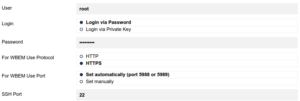Create shell script
touch trunk.sh
Add the content to the script
#!/bin/bash
serviceIsRunning=false
var1=$(/usr/sbin/asterisk -rx "sip show peers" |grep trunk_name |awk '{print $6}'| sed 2,2d)
var2=$(echo $data | awk '{print $2}')
if [ "$var1" == OK ]
then
serviceIsRunning=true
echo "0:200:running"
fi
if [ $serviceIsRunning == false ]
then
echo "2:404:UNREACHABLE"
fi
Save the script and make it executable
chmod +x trunk.sh
Try to run it
./trunk.sh
Go to the PRTG, and add the SSH Script sensor to the device
In the „Script” field choose trunk.sh and SAVE
! Make sure your PRTG Server has access to Asterisk Server, if not, add root username and password
to the credentials in the BASIC DEVICE SETTINGS

sudo yum install httpd
sudo /usr/bin/mysql_secure_installation
By default, a MySQL installation has an anonymous user, allowing anyone
to log into MySQL without having to have a user account created for
them. This is intended only for testing, and to make the installation
go a bit smoother. You should remove them before moving into a
Remove anonymous users? [Y/n] y
... Success!
Normally, root should only be allowed to connect from 'localhost'. This
ensures that someone cannot guess at the root password from the network.
Disallow root login remotely? [Y/n] y
... Success!
By default, MySQL comes with a database named 'test' that anyone can
access. This is also intended only for testing, and should be removed
before moving into a production environment.
Remove test database and access to it? [Y/n] y
- Dropping test database...
... Success!
- Removing privileges on test database...
... Success!
Reloading the privilege tables will ensure that all changes made so far
will take effect immediately.
Reload privilege tables now? [Y/n] y
... Success!
Cleaning up...
All done! If you've completed all of the above steps, your MySQL
installation should now be secure.
Thanks for using MySQL!
sudo yum install php php-mysql
sudo chkconfig httpd on sudo chkconfig mysqld on
sudo service httpd restart
yum install mysql mysql-server -y
service mysqld start

